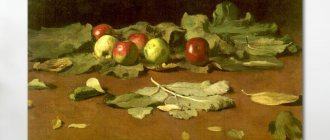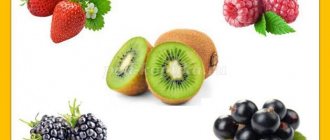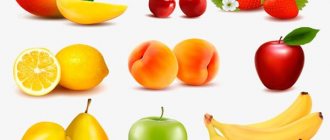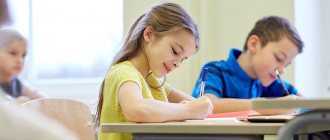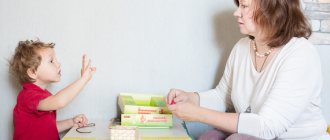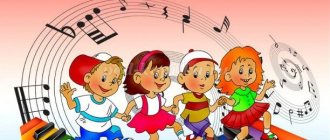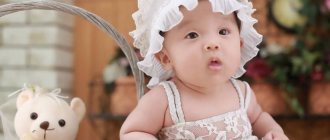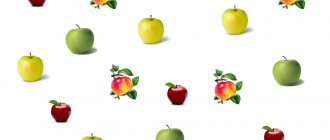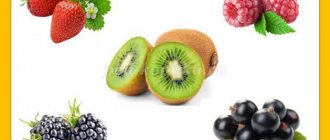Fruits:
materials for games, conversations and activities with preschool children. Finger gymnastics. Entertaining speech exercises and games for children. Physical education minutes. Cartoons.
In this article you will find:
- Conversation about fruits.
- 10 speech games on the topic “Fruits”.
- Finger gymnastics.
- Three ideas for physical education minutes.
Additional material for the article - riddles about fruits can be found in the article "Riddles"
Conversation about fruits L.K. Schleger. 1913
Preparing for the conversation.
There are different fruits in front of the children. They name them, determine their shape, colors. Determined by touch and taste with eyes closed.
Catalogs of fruits should be at hand; drawings in paints (that is, color pictures); artificial fruit
Conversation.
What do fruits grow on? What is the name of the tree on which apples grow? Can plums grow on an apple tree? What does a ripe apple look like? What does it taste like? (Sweet, juicy). Who colored the apple so much? What protects the apple pulp? (Skin). When is the apple ripe? The beauty of an apple tree hung with ruddy apples. Has anyone ever seen an apple tree with apples? What are the apples sitting on?
Who can tell me how an apple grows? Is it always so big and ruddy? What color is an unripe apple? What does it taste like? Before the apple appears, the apple tree blooms. When does it bloom? In the spring. Has anyone seen an apple tree in bloom? We'll look at it in the spring, but for now let's look at the picture.
Let's see what's inside the apple , cut it - one lengthwise, the other across. What are the seeds in and how many are there? Why do apple trees need seeds? Why do you need pulp? She guards the seeds. What color are ripe seeds? What about the unripe ones?
What kind of seeds do cherries have? At the plum?
Who eats ripe fruits? Do some people eat and love them? Do people eat seeds? They spit them out. What do birds eat? Seeds fall on the ground, and what grows from them?
What do you sometimes find in apples, pears, plums? Worm. How did the worm get into the apple tree? Does the worm remain in the apple? He gnaws it and comes out (find an apple with a worm in it). A worm is made into a pupa, and a pupa is made into a butterfly.
What do we make from fruits? What do we make jam from? Has anyone ever seen dried fruit? Show and try. What else is made from fruits? Kvass, liqueur.
Do we grow grapes? What do they make from it? What other fruits do you know that grow in warm countries? Oranges, tangerines, lemons. Are the skins of oranges and lemons as thin as those of an apple?
What fruits does an oak tree or a Christmas tree have? Who collects and eats them? Is this fruit?
Children's work on the topic "Fruits".
- Modeling fruits, drawing them.
- Cutting and pasting (applique).
- Cutting out pictures of fruits from catalogs and magazines.
- Illustration “Apple picking”.
- Fruit stand (making a model for children's games together with the children)
Question for educators to consider:
Exactly 100 years have passed since the publication of this conversation for young children by the talented teacher Louise Karlovna Schleger! Have we and our children changed? What is different about the conversation about fruits by L.K. Schleger from modern conversations about fruits in kindergarten? What requirements for a conversation with children were taken into account when compiling this conversation? What would you change about it?
You will learn more about conversations with children and about our history of methods for developing children’s speech from the article “Conversation in kindergarten” based on materials from the book by E.A. Flerina “The Living Word in a Preschool Institution.”
Calendar plan on the topic “Fruits” for a week for preschool educational institutions
Theme of the week: “Fruits”
Monday
Morning.
1. D/I “Guess by description” Purpose: learn to describe fruits.
2. D/I “What is this color?” Purpose: to consolidate knowledge of colors.
3. Situational conversation “Fruits for food - good or bad” Examination of the illustrations “What is rich in this autumn” - repeat the names of the fruits.
4. Individual work on speech development. Objectives: to train children in forming adjectives from nouns (maple leaf - maple, linden - linden); learn to work in pairs; tactfully correct your partner’s mistakes.
5. Work in a corner of nature: caring for indoor plants. Goal: to develop a caring attitude towards plants.
6. D/i “Let’s pick fruit” - orientation in space, the ability to distinguish fruits from vegetables.
7. Guessing riddles about fruits - develop logical thinking and speech.
GCD.
1.
Speech therapy
2.
H.E.R.
Modeling “Fruits on a Plate” Program objectives:
to
continue familiarizing children with the techniques of sculpting fruits and plates, to convey a more accurate form, to teach how to achieve expressiveness through a more accurate representation of the shape and size of objects in fruits and plates, to develop fine motor skills when performing various work techniques with plasticine: rolling, flattening, cultivating aesthetic emotions and feelings, accuracy when working with plasticine.
Equipment:
plasticine, stacks, backing board, napkin, fruit on a plate, twigs.
Vocabulary work:
oranges, lemons, tangerines, pomegranates, etc.
Methodical techniques:
riddles, conversation, examination, creation of a creative problem situation, demonstration of a method of action, individual assistance, result.
3.
H.E.R.
Musical Walk:
1. Looking at trees. Goal: to expand knowledge about the state of plants in autumn (cessation of growth, yellowing and falling of leaves, the presence of fruits and seeds).
2. Labor: cleaning up fallen leaves. The goal is to instill hard work
3. Individual work on movement development. Objectives: develop the skills of throwing a ball at a target.
4. Sports game football. Objectives: teach children to play together and act as one team. Promote the development of accuracy, coordination of movements, determination, courage.
2nd floor day
1. S. r. And. “Fruit Cafe” - develop game dialogue, the ability to compose a game plot, combine several games, and cultivate a socially active personality.
2. Reading thin. literature r.s.s. “Tops - roots” Purpose: to recall the text, dramatize the fairy tale by roles.
3. S/R game “Fruit Store” Purpose: to introduce the name of fruits into children’s speech, to cultivate a culture of speech.
4. Individual work with children to repeat the names of trees, consolidate the autumn months
5. Work in the book corner - looking at illustrations, photographs, dummies, sets of postcards on the topic.
Walk:
1. Suggest d/i “What does autumn smell like?” Goal: to teach children to choose words to describe their own feelings.
2. P/I “Zhmurki”. Independent play activities on the site.
Tuesday
Morning:
1. Introducing children to books of encyclopedic content. Goal: learn to work with books.
2. Conversation “Work in the garden and vegetable garden.” Clarify the idea that in the fall after harvesting, the beds are prepared for spring planting.
3. I/u “Playing with a fairy tale” - teach to come up with a different ending to fairy tales.
4. D/I “Whose children” Purpose: to consolidate knowledge about plant fruits.
5. “Smart lacing” - development of fine motor skills and imagination
6. Labor in the canteen. Goal: to strengthen the ability to set the table for breakfast.
7. D/i “The fourth odd one” - develop thinking operations
GCD.
1.
Speech therapy
2.
P. R. FEMP.
"Repetition" Program tasks:
consolidate ordinal and quantitative counting within 10, improve plane orientation skills, consolidate knowledge about numbers, consolidate knowledge about the composition of numbers from 2 to 5, consolidate knowledge about geometric shapes (rectangle, circle, oval, square, triangle), practice comparison objects by size, practice coordination of movements: right, left, work in notebooks - develop fine motor skills.
Vocabulary work
: left, right, before, after, between, before, behind, next to
Material
: numbers, geometric shapes, d/and “compare by length”, workbooks, simple pencils.
Methodical techniques
: org. moment “Tell me who is standing...”, d/i “Show the number”, comparison by length, physical exercise, work in a notebook, result.
3.
F. R. Physical education No. 1
II
half.
day H.E.R. Drawing "Still Life" Program tasks :
Continue to teach children to draw from life, convey the characteristic features of color, structure and shape. Strengthen children's ability to use brushes and paints. Create a desire to draw and invent. Cultivate accuracy in work and aesthetic taste.
Vocabulary work:
still life, dummies, vegetables, fruits, berries, flowers, paintings, artists
Methodological techniques:
examination of the vase - give a full analysis of shapes, colors, proportions. Compare the top and bottom, finding the difference.
Questions for children: What shape is the vase? What do the base and neck of the vase look like? What colour?
What is higher - a vase or fruit? How big are the fruits compared to the vase?
Walk:
1. Looking at trees. Objectives: to promote a generalization of ideas about the structure, growth and development of plants; develop the ability to generalize based on essential features; expand children's understanding of parts of plants; cultivate interest in plants; accumulate experience of an attentive and caring attitude towards them.
2. Labor – collecting large debris on the site. Goal: to cultivate hard work.
3. Didactic game “Name three objects.”
4. Outdoor game “Hunter and Hares”.
2nd floor day.
1. The game “We Count Fruits” develops the ability to use counting skills in everyday life.
2. Playful activities in the music corner. “Find out which child sings” - improve children's hearing.
3. The story of V. Sukhomlinsky “Apple Dawn”. Goal: Improve the ability to retell and draw up a retelling plan.
4. The game “Magic Chair” - to cultivate the ability to be affectionate, to activate gentle, affectionate words in children’s speech.
Walk:
1. Wind observations. Goal: find out how wind affects changes in weather.
2. P/N “Stand where I tell you.”
Wednesday
Morning:
1. Work in a corner of nature: caring for indoor plants. Goal: fostering respect for plants
2. The game “What is eaten raw and what is cooked” to develop phrasal speech and voluntary attention
3. Conversation: “What grows where?” Goal: development of coherent speech.
4. Game "Fourth wheel". Develop logical thinking, strengthen the ability to distinguish between concepts: vegetables and fruits;
5. Canteen duty. – secure the correct table setting.
GCD.
1.
Speech therapy
2.
H.E.R.
Drawing “Fruits on a plate” Program tasks:
introduce children to the type of painting - still life, its content, composition, color selection; teach how to draw fruits, plan your work, navigate on a sheet; cultivate a love of painting.
Demo material:
vase, fake fruits, sheets of paper of different colors for the background, a sheet of white paper.
Handout:
albums, paints, brushes, glasses of water, napkins, stands for brushes, simple pencils.
Vocabulary work:
still life, background, composition.
Methodical techniques:
org. moment, conversation with children, reading a poem, showing a method of action, finger gymnastics, independent and individual work, result.
3.
H.E.R.
Musical Walk:
1. Observation of changes in leaf color, how did they change, why? Goal: to develop observation skills, the ability to draw conclusions during observations.
2. D/I “What comes first - what then?” Goal: to consolidate the stages of plant growth and development.
3. P/I “Obstacle course” Purpose: development of movements.
4. Situational communication “Safety while walking” Purpose: to provide knowledge about the rules of behavior on the territory of the kindergarten: when meeting with various pets, to promote the development of caution.
5. Labor: collecting leaves of various trees and shrubs for the herbarium.
6. Individual work on PHYS I/u “Who will jump higher” - practice high jumps from a place.
2nd floor day.
1. Cognitive and research activity: Show how an apple turns black when cut - this iron changes its beneficial properties for us in the air.
2. D/I “In the garden, in the vegetable garden” Purpose: to consolidate the classification of vegetables and fruits.
3. D/ game “Put the fruit back on the tree”, establish that fruits grow on fruit trees, name them, use plural nouns. Number, fix the colors and name of the fruit. classify according to characteristics, call it a general word
4. Creative workshop: application “Stocks for the winter.” Goal: continue to learn how to create an image from parts, develop a sense of composition.
5. Reading L.V. Voronkova “Pear Apple” T. Teach children to listen carefully and answer questions.
Walk:
1. D/I “What first, what then” Purpose: to consolidate the parts of the day.
2. NRK-Russian folk game “Tsar Potato” Purpose: to practice catching the ball, to develop dexterity.
Thursday
Morning:
1. Work on speech development -D/I “Speak correctly” Develop the ability to correctly use nouns. in plural number of births. case
2. The canteen duty staff must be trained to conscientiously perform the duties of the canteen duty officers.
3. Ethical conversation “Let’s smile at each other.” To form in children the idea that a kind smile and a good mood is transmitted to others, do not spoil the mood of others.
4. Didactic game “Name the juice, jam” (formation of relative adjectives): apple juice - apple;
5. D/i “Find by description” - develop memory, attention
GCD.
1.
Speech therapy
2.
P.R.
FEMP “Guess multi-colored riddles” Program tasks:
Practice dividing a set into parts and combining parts into a whole group; improve the ability to establish a relationship between a set and its part. Learn to count forward and backward within 5. Strengthen the ability to divide a circle and square into 2 and 4 equal parts, compare them and name them. Strengthen the ability to distinguish and name familiar geometric shapes.
Vocabulary work:
part, whole.
Material:
numbers, mathematical signs, scissors, 2 circles for each child, geometric shapes, ball.
Methodical techniques:
org. moment, d/i “Count”, “One and many”, “Count backwards”, dividing a circle into parts, comparing parts, physical exercise, d/i “Find the figure”, result.
3.
F.R. Physical education No. 2
II
half.
day S.K.R. LIFE SAFETY FUNDAMENTALS. "Vitamins for health." Software tasks:
to promote in children the foundations of a nutritional culture as a component of a healthy lifestyle, to reinforce the concepts of “fruits and vegetables”, to introduce them to the products that a person needs every day; teach children to choose the healthiest foods; give an idea of vitamins and their content in foods, help children correctly navigate the range of products of plant origin, consciously choose healthier ones, and, if possible, include them in the daily diet; develop logical thinking and fine motor skills; develop children’s coherent speech and children’s vocabulary; develop the ability to answer the teacher’s questions in full sentences and give reasons for your opinion; to intensify the cognitive activity of pupils, their intelligence, memory, attention, hearing, to form a cognitive interest in rational nutrition, a desire to be healthy; cultivate a desire for a healthy lifestyle and exercise; cultivating a positive attitude towards each other’s answers, promoting active communication between children; show children which foods are healthy and which are harmful to health; lead to the understanding that you need to eat right to be healthy.
Methods and techniques:
conversation; observation; creating a problematic situation; explanatory and illustrative method; game method; joint activities with children.
Vocabulary work:
expand children's vocabulary: “vitamins”, “fats”, “proteins”, “carbohydrates”.
Materials and equipment:
paper or fabric tracks of different colors; Ljuboznayka, Kubik, Bead (soft toys), Vitaminka doll (puppet theater); box with story pictures; fruits, vegetables, products - illustrations of models of vegetables, fruits. signal cards: green and red; stencils in the shape of jars, plasticine, boards, stacks.
Walk:
1. Observation of a birch tree. Goal: to continue acquaintance with the birch, highlighting the characteristic features and changes associated with the time of year, to cultivate a caring attitude towards the tree as a living object of nature.
2. “Safety while walking” Purpose: to provide knowledge about the rules of behavior on the territory of the kindergarten
3. Labor activity: sweeping paths, picking up garbage Goal: to cultivate the ability to work together.
4. Competition “The most beautiful autumn bouquet” (from fallen leaves)
5. NRK - Outdoor game "Trap" - follow the rules of the game.
2nd floor day
1. S. r. and “Fruit Shop” to develop emotions that arise during role-playing and story-based game actions
2. D/I “Put the fruit back on the tree” to develop thinking operations (generalization, comparison, perception)
3. Constructive game “Fruit for a Giant” Purpose: to learn how to make fakes from Lego.
4. Dramatization of the fairy tale: “Tops and Roots.” Strengthen children's ability to use various means of expression in conveying the images of fairy tale heroes.
5. Modeling: “A treat for bunnies and hedgehogs” Improve the ability to sculpt the basic shape of an object with the hands of both hands, and the details with the fingers.
Walk:
1. Observing twilight, note that daylight hours are noticeably decreasing.
2. Reinforce the signs of autumn. D/I “When does this happen?” P/I “Hurry up to run out”
Friday
Morning.
1. Printed board game “Match a Pair”. Develop the ability to select pairs of objects based on a given characteristic.
2. Canteen duty - teach to conscientiously perform the duties of canteen duty officers
3. D/i “Name the color of the fruit” to develop thinking.
4. UMK-game “Commander” - consolidation of words in the imperative mood
GCD
1.
P.R.
FCCM "Fruits". Software tasks :
Clarify and expand children’s knowledge about fruits, their growth, and benefits for human health; develop dialogical and monologue speech; improve skills in examining objects; develop quick thinking and fine motor skills; cultivate respect for agricultural work; teach children to answer questions and construct complete sentences.
Vocabulary work:
citrus, plum, pear, horticultural.
Material:
caterpillar toy, pictures on the topic, ball.
Methodical techniques:
surprise moment, riddles, conversation on the topic, d/game
“Pick a color”
.
What color? (orange, golden orange, pinkish, yellow, red, yellow-red, green, blue, purple). Game "Pick a Shape"
.
What shape? (triangular, oval, round)
.
Game "Wonderful bag"
.
What does it feel like? (smooth, rough, velvety, strong, hard, soft)
.
Fizminutka, d/game “Curious Tongue”
.
What does it taste like? (sweet, sour, sweet and sour, tasty, tasteless, fresh, ripe, juicy). Game "Curious Nose"
.
What does it smell like? (fragrant, fragrant)
, result.
2.
P.R./H-E R. Construction from paper “Apple”
Program tasks:
learn to construct an apple out of paper, highlighting its characteristic features. Develop the ability to follow verbal instructions. Strengthen the ability to work with paper (practice folding strips like an accordion, marking according to a template, making a cut in the middle of an apple). Develop fine motor skills, memory, thinking, imagination, creativity, artistic taste; cultivate goodwill, a desire to help, and help create a joyful emotional mood in children.
Material:
pictures of apples, dummies of apples, a sample, a strip of thick colored paper, a rectangle for a leaf, glue, scissors, a tray, oilcloths, rags.
Vocabulary work:
liquid, rosy, sour, sweet.
Methodical techniques:
org. moment of a riddle, conversation, examination of a sample, demonstration of a method of action, finger gymnastics, independent and ind. work, exhibition of works, result.
3.
Physical education in games while walking.
Exercise children in running and overcoming obstacles; develop dexterity in exercises with the ball; repeat the task while jumping. Game exercises: “Throw it - catch it”, “Don’t get caught”, Outdoor game “Shapes”.
Walk:
1. Observation of insects Objectives: to clarify the idea of preparing insects for winter; cultivate cognitive interest in insects; develop observation skills and a desire to communicate with nature.
2. Labor: preparing land for planting in winter.
3. Work on safe behavior on the site. Exercise children in orientation in space (turns left, right, around)
4. Didactic game “Guessing riddles.” Goal: expand the stock of nouns in the active dictionary.
2nd floor day
1. D/I “Fruit” dominoes – develop attention
2. Work in the book corner - looking at illustrations, photographs, dummies, sets of postcards on the topic.
3. Reading the fairy tale by V. Suteev “The Bag of Apples”, conversation on the content of the fairy tale.
Walk:
1. Monitoring the movement of cars on the road. Goal: to generalize and expand children’s knowledge about traffic rules.
2. P/i “We’ll weigh it by eye.” Teach children to determine the distance to nearby objects by eye.
Speech games with preschool children on the topic “Fruits”
Game 1. Ladder in the garden. Choose a word.
Together with your child, come up with as many words as you can about what kinds of fruits there are. For example, today we will play with the word “apple” - “What kind of apple can there be?”, and next time with the word “pear” - “What kind of pear can there be?” You can choose words on the road, on a walk, on the bus or in the car. But the best thing is to play!
How to generate interest in a word matching game?
Speech exercises are difficult for children, so it is best to carry them out in a playful way and so that the child can clearly see the result of his efforts. I came up with my own technique for this - “visual game assessment of the result of speech.” This is how I do it.
I usually draw a large tree on an easel with a felt-tip pen (you can also draw a tree on a piece of paper or on a board). On the tree I draw fruits, but they must be drawn very high from the ground. There is a ladder next to the tree. The staircase is drawn as two vertical parallel lines. But - this is important - there are no steps drawn on it!
How we play: we select words and climb up the stairs to get fruit. One word = one step.
As soon as we have chosen one word, I draw one step. We found another word - I draw another step. How many words were chosen - so many steps appeared on the ladder! With each word, more steps are added, and we climb higher and higher (you can rearrange the children’s figures according to the image of the ladder). The task is to get to the top of the tree, and for this you need to choose a lot of words!
There should definitely be a pleasant surprise waiting for children at the top of the tree! When children take an apple (or plum) from the crown of a tree, on the back of the picture they should find something - a plan indicating the place where a surprise is hidden, a riddle, a small gift, a beautiful piece of paper, words of congratulations from the Gardener, a drawn medal, magic words etc.
Hint for adults
Words for the game: fragrant, big, tasty, tasteless, sour, sweet, rosy, tender, fragrant, juicy, bulk, red, yellow, golden, striped, ripe immature, ripe, round, oval, elongated, soft, hard, rotten , wormy, dried, large, small, boiled, summer, early, early ripening, southern.
Helpful advice:
- It is better if you say in this game words that are rarely found in everyday communication (“fragrant apple”, “fragrant apple”, “ripe apple”), and the children will select simpler words (“sweet apple”, “round apple”) ", "ruddy apple"). If children find it difficult, then you can suggest words to the kids with a gesture, suggest the first syllable, remind them of a familiar line from a poem in which this word appears
- This game is difficult for children at first. But later, interest and attention to words and expressive speech develops. Children begin to be very attentive to the words and literary texts that are read to them, listen to the speech of adults and notice vivid figurative epithets in it. Therefore, the game is very useful for developing attention to language, for enriching and activating children’s vocabulary, and for preparing for school.
- I really love reading Y. Akim’s poem to children, which contains many expressive epithets. Listen to it as a child and find beautiful, special, expressive words in it.
“The apple is ripe, red, sweet, the apple is crisp, with a smooth skin. I’ll split the apple in half, I’ll share the apple with my friend.” (Ya. Akim).
Here are more poems about apples, in which there are many beautiful figurative words for speech play.
Fragrant, rosy, Some are sweet, some are spicy, Some are sour, some are tart, Some are soft, some are strong. There are fresh, dried, and even soaked.
The most important sweet fruit grows in our garden. It is amber and fragrant, sweet and sour, golden. Large, round and crispy, the King's son is real! There is one with a ruddy side and a cheerful worm. Our apple tree amazingly gave us a lot of apples: very sweet, aromatic, and so pleasant to the taste.
Game 2. I know.
The first player begins: I know a lot of fruits: an apple. The second player continues: I know a lot of fruits: apple and pear. The third builds the chain further: “I know a lot of fruits: apple, pear and plum.” The task is to continue the chain and not confuse anything. An adult can make a deliberate mistake in a game, for example, naming a vegetable instead of a fruit. Will children notice this mistake?
The game develops attention and memory.
Tips for playing the game:
For children, the chain should not be too big! If there are a lot of children playing, then it is better to compose not one long chain of words, which is difficult to remember, but several chains.
When making a chain, you can string large wooden parts onto a cord. This way we can clearly see how many words we have remembered and selected.
Game 3. Let's collect fruits in a basket.
Each player names one fruit. If he named correctly, then he puts the cube in the basket. One word is one cube. The task is to fill the basket with words - cubes, remembering and naming as many fruits as possible. You can play against the clock - you need to fill the basket in 2 minutes. This is a fairly long period of time, sufficient to complete the task.
What children can name: apple, pear, quince, cherry plum, shadberry, apricot, peach, plum, lemon, orange, grapefruit, tangerine, pomegranate, pineapple, persimmon, banana, mango, avocado, kiwi and other fruits.
You can “put” in the basket not only the names of fruits, but also phrases. For example: “fragrant apple” - put a cube. Now we need to come up with the next phrase - “golden pear”. Next is a new phrase – “blue plum”. And so we fill the basket.
Game 4. Classification. Fruits and vegetables.
Children are given pictures of mixed fruits and vegetables. You need to put fruits in one basket and vegetables in another.
Be sure to ask your child: “Why do you think this is a fruit?”
To summarize children’s ideas about fruits and clarify the general concept of “fruit,” with children 4 years of age and older, you can conduct an exercise with pictures to develop logical thinking, “What are fruits?”
Step 1. Place 3-4 pictures of fruits in front of the child. For example, apple, pineapple, banana, plum. You can also use real fruits or dummies. Ask what's different
these items?
Let the child compare
them with each other and tell them that they differ: a) in color - “the plum is purple and the apple is scarlet”, b) in size “the plum is small and the pineapple is large”, c) the nature of the surface (smooth, rough), d) shape (round, oval, long - short).
Step 2. After this, ask the main question: “ How are these pictures similar?” What do these items have in common?
" It's a difficult question. If necessary, help your child with guiding questions.
- What do people do with them? Are eating. So, they are similar in that they are what? Right! Edible.
- Where do they grow?
Yes, they all grow not on the ground, but on trees, in the garden. - Can they grow on their own in a field or forest?
No. Who planted them? Human! Can they grow without care or watering? So how are they similar?
Step 3. After discussion, conclude with your child that all these pictures depict plants - fruits. And again discuss the main characteristics of fruits. Fruits are plants, they are always edible, they grow in the garden, they are planted and grown by people, people take care of them. People make jam, compotes, jellies, marmalade and other delicious treats from fruits.
Step 4. Ask them to select fruits from pictures of different foods. Why is this a fruit, you ask? Maybe it's a vegetable? Emphasize the difference - fruits grow on trees in the garden. And vegetables grow on the ground in the garden.
Game 5. What is made from fruits? Cheerful cooks.
At the beginning of the game, we remember all the dishes that are made from fruits. Remember the most favorite dishes of your children and your family.
Hint for adults: juice, compote, jelly, fruit drink, jam, jelly, marmalade, candied fruits, raisins, dried apricots and other dried fruits, Turkish delight are made from fruits. Do you remember anything else? I will be glad to see your additions in the comments after the article.
And then we start playing with the children - “cooking” their favorite dish. For example, let's make marmalade. We depict how we stir the mass in a saucepan, how we spread it with a spoon on a baking sheet, and then cut it into slices with a knife and treat the toys. And at this time we talk about marmalade, learning to form adjectives from nouns.
Let's make marmalade from different fruits, and we will succeed (we start the phrase, and the children suggest the answer). Apple marmalade - what should we call it? Apple.
- Plum marmalade – what kind? Plum. (A common mistake is “creamy”! Please note to the child that creamy is made from cream. And made from plums is plum)
- And from pears? Attention! There are common mistakes here, the correct option is pear.
- And what kind of peaches? Peach!
- From apricots - ? Apricot.
- From orange - ? Orange.
- From tangerine - ? Tangerine.
And then we start playing in the cafe. Each time we don’t just say a word, but depict a whole scene - we treat visitors, taste it, lick our lips, make suggestions, ask questions. And at this time we say: “Oh, how fragrant our apple marmalade turned out. Would you like to try the pear one? Maybe you’ll like plum better?” If a child makes a typical mistake, for example, says “apple” instead of “apple,” then it is best to treat the guests – the toys – with apple marmalade, saying this word many times in the game in different phrases: “Would you like to treat yourself to apple marmalade? It is very tasty!". Or: “Our apple marmalade is very aromatic and not cloying, you will like it!”
One of the options for such a game is to persuade the character to try apple marmalade, praising it in every possible way. And each time repeating its name and reinforcing the correct version of the word in speech. Naturally, at first the toy refuses, and then agrees. And she really, really likes apple marmalade. And your baby, while playing, masters a new word for him, and will no longer make mistakes in it! And before you know it, you will learn to speak grammatically correctly!
In the future , you will only need to remind him of the correct option in everyday communication: “Remember, we played with fruits. What is the correct name for apple marmalade? Correct your mistake. What a clever girl! Yes, apple!” Never repeat your child's mistakes. It is very important for a child to hear grammatically correct speech from adults!
Game 6. Call me affectionately.
- Apple - ? Bullseye.
- Plum - ? — Slivka
- Apricot - ? - Apricot.
- Pear - ? - Grushka.
- Orange - ? - Orange.
- Mandarin - ? - Tangerine.
- Lemon - ? Lemon.
Game 7. Wizards.
Give your child a magic wand and let him turn into a wizard. An ordinary pencil wrapped in foil can act as a stick. For beauty, you can attach a brush, bell or other attribute of magic to the pencil.
The task of our little wizards is to grow a lot of fruit. An evil wizard bewitched the garden, and only one apple grew in it. But our little wizard waves his magic wand, and a lot of things happen? Apples!
- There was one plum, a wave of the stick, and it turned out to be a lot? Drain.
- Instead of one orange, many grew? Oranges.
- There was one pineapple, but now there are a lot of other things? Pineapples.
- There was one pear. Has it become too much? Grush.
- There was one banana hanging on a branch, but now there are a lot? Bananas.
In this grammar game, your child gets to know the genitive plural of nouns. You will be able to see and correct common grammatical errors. For example, children may say that there are a lot of “apples” instead of the correct version of “apples.” Children often say that there are a lot of “pears” or “pears” instead of the correct version of “pears”. If the kids make mistakes, then play the following game with them to consolidate their speech skills.
Game 8. What happened.
Place 6 pictures in front of your child. Each picture depicts fruits: bananas, apples, pears, plums, pineapples (you can take another list of pictures). Let the baby close his eyes, and at this time you remove one of the pictures. What's missing? Grush.
In this game, the child also learns to correctly use words in the genitive case.
Visual material (pictures)+ for this game and other games in the article
has already been posted in the section of the website “Library of games, pictures and materials for activities with children” - “Fruits: pictures for children, tasks, speech games.”
Game 9. Fourth wheel.
- Lemon, tangerine, orange, cucumber.
- Pineapple, boletus, apple, pear.
- Pear, plum, fruit, kiwi.
- Plum, pear, compote, apple.
Be sure to ask children why they chose this particular word as extra. Children have their own logic, and it also has the right to life! In addition, the ability to explain and prove one’s point of view, to build arguments is very important in life and begins to develop in a child in preschool age! Take advantage of these baby development opportunities!
Game 10. Guess who?
This entertaining and fun game makes it very easy to learn how to use genitive plural nouns correctly. It happens so naturally! Children love to play, they play the game many times, and each time they develop and consolidate their speech skills without any teaching, boring exercises or long explanations - naturally and playfully!
To play you will need pictures, each of which depicts several fruits. You need two identical sets.
One of the children is the leader. He is given one set of pictures. All participants in the game take a picture from another set.
The presenter's task is to guess who has what. The dialogue goes like this:
— Do you have lemons? No, I don't have lemons! Do you have oranges? No, I don't have any oranges ! Do you have apples? No, I don't have apples ! Do you have pears? No. I don't have pears! Do you have tangerines? Yes, I have tangerines.
It is discussed in advance how many questions the presenter can ask one player. Usually this is 4-5 questions. If he was able to guess, then the children change roles in the game. The presenter becomes the player, and the child whose picture was guessed goes on to guess further.
If the presenter has not guessed right after 4 questions, then he continues to guess.
You can play this game together with your baby. Then the adult asks questions, and the child answers. Then switch roles.
Summary of a lesson on speech development in the middle group “Description of fruits”
Educational area
Speech development
The topic of the lesson is “Description of fruits.”
Implementation of program content in educational areas :
“Speech development”, “Artistic and aesthetic development”, “Cognitive development”, “Social and communicative development”.
Types of children's activities:
gaming, communicative, educational and research.
Goals:
learn to compare and describe fruits.
Program tasks
:
Educational: continue learning about fruits by solving riddles; learn to describe fruits by color, shape, size; learn to use adjectives in speech, forming them from nouns.
Developing: develop, knows how to maintain a conversation, expresses his point of view, logical thinking, attention.
Educational: To cultivate a caring and loving attitude towards nature, which has generously endowed us with its riches; develop the ability to listen to each other;
Vocabulary work:
fruit, fruity, orange, lemon, cherry, plum, peach,
Preliminary work:
looking at pictures of fruits, the game “What Grows Where”, a conversation on the topic “Fruits”, “Fruit preparations”.
Materials and equipment:
Hedgehog and Little Fox, envelope, pictures of fruits, ball, sheets of paper with images of ovals and circles; two pictures of fruits to find the differences, replicas of fruits, fresh fruits.
Contents of organized children's activities
1. Organizational moment.
Educator: Good afternoon! Happy hour!
I'm very glad to see you.
You turn to each other and smile.
And sit down quietly.
Educator: Guys, who came to us? (Hedgehog and Little Fox are sitting on chairs near the board, holding an envelope)
Children: Hedgehog and little fox
Educator: Yes, these are our friends. Guys, look, they are unusual today, Hedgehog has prepared something for us in an envelope. Let's open it and read it. (Takes the envelope and opens it)
Guys, our friends invite us to play and solve riddles.
Children: stand in a semicircle and look at the board.
2. Guessing riddles. Description of fruits by color and shape.
1.Round, ruddy
It grows on a branch
Adults love him
And little children (apple)
(hang a picture of an apple on the board and the children must talk about it).
Educator: What is this? What color is the apple? What shape? What size is an apple?
Children: The apple is red, round in shape. The apple is big.
2.With orange skin,
Looks like a ball
But the center is not empty,
And juicy and tasty. (Orange)
(There is a picture of an orange on the board).
Educator: What is this? What color is the orange? What shape? What size? Do you think an orange is sweet or sour?
Children: Orange, round in shape...
3.It's almost like an orange
Thick skinned, juicy,
There is only one drawback -
Very, very sour (lemon)
(there is a picture of a lemon on the board).
Educator: What is this? What color is lemon? What shape is it? What size is a lemon?
Children: answer questions
4.Blue uniform, white lining,
It's sweet in the middle. (Plum.)
(on the board there is a picture of a plum).
Educator: What is this? What color is plum? What shape? What size is the plum?
Children: answer questions
5. A whole herd of horses on one leash. (Grape.)
Educator: What is this? What color are grapes? What shape? What size are the grapes?
Children: answer questions
Educator: I’m sitting on a tree, round like a ball,
Red as blood, sweet as honey. (Cherry.)
Educator: What is this? What color are cherries? What shape? What size is the cherry?
Children: Cherry is red, round in shape. Small cherry.
Educator: Well done, guys. All the riddles were solved.
Educator: Guys, how can you call an apple, orange, lemon in one word? What is this? Children: fruit.
Educator: Guys, where do fruits grow?
Children: in the trees
Educator: What are the names of the trees on which fruits grow?
Children: fruit
Educator: Where do fruit trees grow?
Children: in the garden.
Educator: What is the name of a garden in which there are many fruit trees?
Children: orchard
Educator: Well done! The Hedgehog and the Little Fox are also happy with you.
Physical school
Educator: Let's rest a little. Leave the tables and come to me. Stand in a circle. And we will put the Hedgehog and the Little Fox in the center of the circle.
Children: Go out to the teacher’s carpet and stand in a circle.
“Yesterday we walked in the garden, They walk in a circle, holding hands.
We planted currants. They depict how they dig a hole and plant a bush in it.
We whitened the apple tree with lime and whitewash. Move your right hand up and down.
We fixed the fence. Simulates hitting with a hammer.
We started a conversation: They stand facing in a circle
- Tell me, our gardener,
What will you give us as a reward? One finger is bent for each name.
I will give you lilac plums and honey pears as a reward,
The largest ripe apples, They stretch their hands forward.
A whole kilogram of cherries
This is what I will give you as a reward.
A whole kilogram of cherries, that's what I'll give you as a reward.
3. Game “Which one? Which?".
Educator: And now we will sit down on the palace. The Hedgehog and the Little Fox will roll the ball for you and name the color and object in the singular,
for example, a yellow pear, but you have to say how it will be in the plural - yellow pears ..
Educator on behalf of the Hedgehog and the Little Fox: orange orange
Child: orange oranges
4. Coloring.
Teacher: gives each child a sheet of paper on which ovals and circles are depicted.
Children: according to the teacher’s instructions, paint the figures, then determine what the painted figure looks like.
Instructions: Color the shape in the first lower right corner green (apple)
;
in the upper left corner - yellow (lemon)
, in the middle - orange
(orange).
5. Game " Treats ".
Educator: Guys, but E. and L. don’t know why people grow so many fruits. After all, if you don’t eat them all at once, what will they do?
Children: they will spoil, they will not taste good
Educator: Let's tell our friends how to store fruit.
Children: boil, dry, freeze
Educator: What can you cook from fruits?
Children: jam, compote, juice, marmalade
Educator: I am the presenter, I give you a piece of fruit and ask: “What kind of orange juice?”
Child: orange
Educator: “What kind of peach juice?”
Child: peach
Educator: “What kind of apple juice?”
Child: apple
Educator: “What kind of pear juice?”, “What kind of banana juice?”, “What kind of lemon juice?” (you need to play with each child)).
6. Comparison of images.
Teacher: shows a picture on the board
Children compare two pictures, find and name the differences.
7. Game “Forgetful buyer”.
A “seller” and a “buyer” are selected. Models or pictures of fruits are laid out on the table. The “buyer” says that he forgot the name of the item he wants to buy. The “seller” asks to describe the item: color, shape, taste, what it feels like, what it’s like inside. Based on the description, the “seller” guesses the fruit that the “buyer” wants to buy.
8. Reflection. Game "Define the taste."
Educator: Hedgehog and Little Fox brought us treats. Now you and I will put blindfolds on our eyes, go up to the table and taste what kind of fruit it is? Well, the Hedgehog and the Little Fox will see if you complete the task correctly or not. Children: close their eyes and take the prepared fruits into their mouths and guess what they ate.
Educator: Well done! It's time for the Hedgehog and the Little Fox to return to the forest, let's say goodbye to them. Goodbye, guys..
Children: Goodbye
Orange.
We bend our fingers one by one.
We shared an orange. There are many of us, but he is alone! This slice is for hedgehogs, This slice is for urchins, This slice is for ducklings, This slice is for kittens. This slice is for the beaver, And for the wolf it is the peel!
Compote.
We depict actions in accordance with the text:
We will cook compote, We need a lot of fruits: We will chop apples, We will chop pears. Squeeze out the lemon juice, drain, and add sand. We cook, we cook compote. Let's treat honest people.
Fruits.
We bend our fingers one by one.
This finger is an orange, He is, of course, not alone. This finger is a plum, delicious, beautiful. This finger is an apricot, growing high on a branch. This finger is a pear, Asks: “Come on, eat it!” This finger is a pineapple, a fruit for you and for us.
Lesson: fruits, healthy foods, junior group 1
Summary of a lesson on the surrounding world in junior group 1 “Vegetables and fruits are healthy foods”
Integration of educational areas: “Cognition”, “Communication”, “Physical Education”, “Health”.
Types of children's activities: gaming, communicative, motor.
The purpose of the teacher’s activity: to form in children ideas about vegetables and fruits and their beneficial properties for humans.
Tasks of the teacher:
1. To form in children ideas about vegetables and fruits as vitamins beneficial for health ;
2. To consolidate children’s knowledge about the characteristic features of vegetables and fruits : color, shape, taste;
3. Develop children's sensory sensations;
4. Form an idea of caring for your health.
Planned results of the development of integrative qualities of a preschooler: emotionally and interestedly follows the development of action in games (the meeting of Stepashka and Piggy); answers the teacher’s questions; uses different methods of examining fruits and vegetables ; shows positive emotions during physical activity.
Materials and equipment: dolls Stepashka and Khryusha, dummies of vegetables and fruits , a basket, 2 plates, illustrations of trees and beds, natural fruits and vegetables .
Fun physical education minutes:
Harvest.
Show actions: carry a ladder, set up a ladder, pick pears, put them in boxes, load them into the car.
2. How a gardener grew an apple tree.
Show actions: the gardener digs a hole, plants an apple tree, whitewashes the trunk of the apple tree, waters, fertilizes, prunes, and collects fruits.
3. Apple.
That's an apple! It's full of sweet juice! (stand up, arms to the sides, stretch) Stretch your hands, pick an apple! (hands up, stretch up) The wind began to shake the twig, it’s hard to pick an apple! (arms up, bend to the sides) I’ll jump up, stretch out my hand and quickly pick an apple! (jumping up, clapping overhead)
